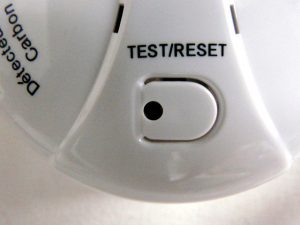Carbon Monoxide Poisoning in Michigan Hotel
A couple was found unconscious in a Michigan hotel room after a suspected carbon monoxide poisoning, according to MLive. Luckily, they had called management, saying that there was heat coming out of the vents in their room. If it had not been for that phone call, they may have died in the room that day.

Carbon monoxide detectors should be installed with fresh batteries. CO detectors should be tested on a regular basis. (Flickr / Creative Commons / Judy van der Velden)
The entire hotel was evacuated. About 50 rooms were occupied. Nobody else had complained besides the couple.
The couple was about 60 years old, and they had their dog with them. The dog is expected to survive. The couple was unconscious when maintenance came to the room.
It is still unclear why the heat was turned on Monday. As of this morning, they were in stable condition, receiving oxygen at the hospital. Research shows that hyperbaric oxygen can be more effective than normobaric oxygen in reducing delayed neurological sequelae, the after-effects of CO poisoning. It is unclear what kind of oxygen they are receiving. We hope it is hyperbaric oxygen.
The carbon monoxide readings in the first floor room were extremely high. Safe levels are about nine particle parts per million. In the room, it was 434 parts per million. In the hallway, it was 150 parts per million. Any exposure that results in unconsciousness in the patient is likely to leave significant long term damage. Hyperbaric should be demanded here.
Carbon monoxide has been a known poison for more than a century. In 1920, Lewin said, “Carbon monoxide causes more health problems and death every year than any other poison or many together.” His remarks were echoed a century later in 1996 by Krenzelok: “Carbon monoxide is responsible for more poisoning fatalities every year than any other toxic agent.”
The affinity of carbon monoxide for hemoglobin is about 300 times greater than that of oxygen. The carboxyhemoglobin level in the blood can be a telling number. It can give an idea of how badly the person was poisoned. However, the number will go down when exposed to oxygen and fresh air. It is unclear what their carboxyhemoglobin levels were, or the other people in the hotel for that matter.
Carbon monoxide is produced by the incomplete combustion of almost any carbon-containing material, such as coal, wood, peat, dry grass, or other fossil fuels, writes Dieter Pankow in Carbon Monoxide Toxicity (2000).
The effects of carbon monoxide poisoning include effects on the nervous system, such as headaches, dizziness, weakness, partial paralysis, convulsions, and changes in perception, including changes in the visual and auditory systems.